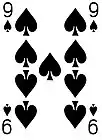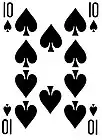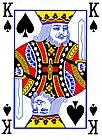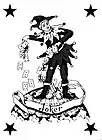二
| ||||||||
Translingual
| Stroke order | |||
|---|---|---|---|
 | |||
Han character
二 (radical 7, 二+0, 2 strokes, cangjie input 一一 (MM), four-corner 10100, composition ⿱一一)
- Kangxi radical #7, ⼆.
Derived characters
- Index:Chinese radical/二
References
- KangXi: page 86, character 1
- Dai Kanwa Jiten: character 247
- Dae Jaweon: page 175, character 6
- Hanyu Da Zidian: volume 1, page 2, character 1
- Unihan data for U+4E8C
Chinese
| simp. and trad. |
二 | |
|---|---|---|
| variant forms | 貳/贰 financial 弍 𠄠 | |
Glyph origin
| Historical forms of the character 二 | |||||||||||||||||||||||||||||||||||||||||||||||||||||
|---|---|---|---|---|---|---|---|---|---|---|---|---|---|---|---|---|---|---|---|---|---|---|---|---|---|---|---|---|---|---|---|---|---|---|---|---|---|---|---|---|---|---|---|---|---|---|---|---|---|---|---|---|---|
| Shang | Western Zhou | Spring and Autumn | Warring States | Shuowen Jiezi (compiled in Han) | Liushutong (compiled in Ming) | ||||||||||||||||||||||||||||||||||||||||||||||||
| Oracle bone script | Bronze inscriptions | Bronze inscriptions | Bronze inscriptions | Chu Slip and silk script | Qin slip script | Ancient script | Small seal script | Transcribed ancient scripts | |||||||||||||||||||||||||||||||||||||||||||||
 |
 |
 |
 |
 |
 |
 |
 |
 | |||||||||||||||||||||||||||||||||||||||||||||
| |||||||||||||||||||||||||||||||||||||||||||||||||||||
|
References: Mostly from Richard Sears' Chinese Etymology site (authorisation),
| |||||||||||||||||||||||||||||||||||||||||||||||||||||
| Characters in the same phonetic series (二) (Zhengzhang, 2003) | |
|---|---|
| Old Chinese | |
| 膩 | *nis |
| 二 | *njis |
| 弍 | *njis |
| 貳 | *njis |
| 樲 | *njis |
Ideogram (指事) - two parallel lines. Compare with 一, one line meaning one, 三, three lines meaning three, and 亖, four lines meaning four. Duplication of 一 (“one”).
Etymology
From Proto-Sino-Tibetan *g/s-ni-s.
Pronunciation
Definitions
二
- two
- 子曰:「君子之道,或出或處,或默或語,二人同心,其利斷金。同心之言,其臭如蘭。」 [Classical Chinese, trad.]
- From: I Ching, 3rd – 2nd millennia BCE
- Zǐ yuē: “Jūnzǐ zhī dào, huò chū huò chǔ, huò mò huò yǔ, èr rén tóng xīn, qí lì duàn jīn. Tóng xīn zhī yán, qí xiù rú lán.” [Pinyin]
- The Master said, on this, "The ways of good men (different seem). This in a public office toils; that in his home the time beguiles. One man his lips with silence seals; another all his mind reveals. But when two men are one in heart, not iron bolts keep them apart; the words they in their union use, fragrance like orchid plants diffuse."
子曰:“君子之道,或出或处,或默或语,二人同心,其利断金。同心之言,其臭如兰。” [Classical Chinese, simp.]
- second
- 子墨子曰:國有七患。七患者何?城郭溝池不可守而治宮室,一患也。邊國至境四鄰莫救,二患也。 [Classical Chinese, trad.]
- From: Mozi, circa 4th century BCE
- Zǐ Mòzǐ yuē: guó yǒu qī huàn. Qī huàn zhě hé? Chéngguō gōuchí bù kě shǒu ér zhì gōngshì, yī huàn yě. Biānguó zhì jìng sìlín mò jiù, èr huàn yě. [Pinyin]
- Mozi said: There are seven causes of worry to a state and they are: (1) When the outer and the inner city walls are not defensible; (2) When an enemy state is approaching and yet one's neighbours do not come to the rescue.
子墨子曰:国有七患。七患者何?城郭沟池不可守而治宫室,一患也。边国至境四邻莫救,二患也。 [Classical Chinese, simp.]
- † secondary, vice-
- † again, once more
- † two-fold, double
- † fold, times
- † different; other, else
- 二意
- 二心 (èrxīn)
- Short for "twenty, two hundred or two thousand" after hundreds, thousands and ten thousands.
- Short for "twenty cents".
- (dialectal Mandarin) stupid, dumb; silly, thick, lacking mental agility (often in a cute way)
Usage notes
See 兩#Usage notes.
Compounds
|
|
|
Descendants
Others:
See also
| Chinese numbers | ||||||||||||||||
|---|---|---|---|---|---|---|---|---|---|---|---|---|---|---|---|---|
| 0 | 1 | 2 | 3 | 4 | 5 | 6 | 7 | 8 | 9 | 10 | 102 | 103 | 104 | 108 | 1012 | |
| Normal (小寫/小写) |
〇 | 一 | 二 | 三 | 四 | 五 | 六 | 七 | 八 | 九 | 十 | 百 | 千 | 萬/万 | 億/亿 | 兆 (Taiwan) 萬億/万亿 (Mainland China) |
| Financial (大寫/大写) |
零 | 壹 | 貳/贰 | 參/叁 | 肆 | 伍 | 陸/陆 | 柒 | 捌 | 玖 | 拾 | 佰 | 仟 | |||
| Playing cards in Chinese · 撲克牌/扑克牌 (pūkèpái) (layout · text) | ||||||
|---|---|---|---|---|---|---|
| A | 二 | 三 | 四 | 五 | 六 | 七 |
 |
 |
 |
 |
 |
 |
 |
| 八 | 九 | 十 | J | Q | K | 小王 (black), 大王 (red) |
Japanese
Alternative forms
- 弐 (financial or formal)
Readings
Compounds
- 二王 (niō)
- 二月 (nigatsu)
- 二言 (nigon), 二言 (futakoto)
- 二重 (nijū)
- 二乗 (jijō)
- 二百 (nihyaku)
- 二次 (niji)
- 二字 (niji)
- 二塁 (nirui)
- 二階 (nikai)
- 二人 (futari)
- 二心 (nishin), 二心 (futagokoro)
- 二日 (futsuka)
- 二次元 (nijigen)
- 二院制 (niinsei)
- 二毛作 (nimōsaku)
- 二刀流 (nitōryū)
- 二人称 (nininshō)
- 二年草 (ninensō)
- 二枚貝 (nimaigai)
- 二枚舌 (nimaijita)
- 二枚目 (nimaime)
- 二十歳 (hatachi)
- 二十日 (hatsuka)
- 二律背反 (niritsuhaihan)
- 二重人格 (nijūjinkaku)
- 二束三文 (nisoku-sanmon)
- 十重二十重 (toe-hatae)
- 二つ目 (futatsume)
- 二の次 (ninotsugi)
- 二の舞 (ninomai)
Derived terms
Noun
Etymology 2
| Kanji in this term |
|---|
| 二 |
| ふた Grade: 1 |
| kun’yomi |
Originally /huta/: *[puta] > [ɸuta]. The Ablaut form of 一 (hito2, “one”), which it doubles.
Coordinate terms
| Japanese numbers | |||||||||||
|---|---|---|---|---|---|---|---|---|---|---|---|
| 0 | 1 | 2 | 3 | 4 | 5 | 6 | 7 | 8 | 9 | 10 | |
| Regular | 零 (rei) 零 (zero) |
一 (ichi) | 二 (ni) | 三 (san) | 四 (yon) 四 (shi) |
五 (go) | 六 (roku) | 七 (nana) 七 (shichi) |
八 (hachi) | 九 (kyū) 九 (ku) |
十 (jū) |
| Formal | 壱 (ichi) | 弐 (ni) | 参 (san) | 拾 (jū) | |||||||
| 90 | 100 | 300 | 600 | 800 | 1,000 | 3,000 | 8,000 | 10,000 | 100,000,000 | ||
| Regular | 九十 (kyūjū) | 百 (hyaku) 一百 (ippyaku) |
三百 (sanbyaku) | 六百 (roppyaku) | 八百 (happyaku) | 千 (sen) 一千 (issen) |
三千 (sanzen) | 八千 (hassen) | 一万 (ichiman) | 一億 (ichioku) | |
| Formal | 一萬 (ichiman) | ||||||||||
| 1012 | 8×1012 | 1013 | 1016 | 6×1016 | 8×1016 | 1017 | 1018 | ||||
| 一兆 (itchō) | 八兆 (hatchō) | 十兆 (jutchō) | 一京 (ikkei) | 六京 (rokkei) | 八京 (hakkei) | 十京 (jukkei) | 百京 (hyakkei) | ||||
Vietnamese
Han character
二: Hán Việt readings: nhị[1][2][3]
二: Nôm readings: nhì[1][2][3], nhị[2][3][4], nhẹ[1]
References
- Nguyễn (2014).
- Nguyễn et al. (2009).
- Trần (2004).
- Hồ (1976).










































